 American Meteorite Survey
American Meteorite SurveySchoner's
 American Meteorite Survey
American Meteorite Survey
Meteorite Identification Page
Because the earth's crust is rich in iron oxides and iron minerals, meteorite identification is a daunting task for the layman, and even the professional geologist. For over twenty years the American Meteorite Survey has endeavored to find, catalog and distribute meteorites to institutions and collectors. We invite the submission of suspected meteorite samples for identification and appraisal. But in this task very few samples submitted turn out to be meteoric. The average is about one in a thousand. The purpose of this page is to present information that will better aid the reader to recognize meteorites.
SO you think that you may have found a meteorite?
But how can you be sure?
Does your suspected space rock fit the following criteria?
1)
Is it heavy as compared to most rocks?Meteorites have a high specific gravity and tend to be denser than most earth rocks. This is not only because of the types of minerals found in them, but because almost all of them have varying amounts of malleable iron-nickel grains. This amount ranges from a few percent to 100%. About 93% of all meteorites seen to fall are stones, and only about 5% are solid nickel-irons. The rest, less than 2% are the stony irons having an almost 50-50 mixture of stone and malleable iron-nickel. To see the metal or metal grains within a meteorite you must grind a small window on the specimen. Often metal grains appear on broken surfaces of stone meteorites as rust spots, especially if it is weathered. And if the object in question is solid iron-nickel then it will look exactly like a rusty lump or chunk of steel that is silvery inside. Because iron meteorites are comprised almost entirely of malleable metal, when struck with a hammer they will dent or bend rather than break. On the other hand, stone meteorites will pulverize, and within the brittle stony matrix are malleable metal grains that flatten rather than crush. Because malleable iron-nickel is extremely rare on earth, but common in most meteorites, it is one of the distinguishing characteristics in determining whether the rock in question is meteoric or not.

Campos Sales, Brazil; L-5, (stone), Fell Jan 31, 1991. This 96 gram full slice is from a stone that was picked up shortly after a bright meteor was sighted. Notice the white malleable metal grains in this expertly cut specimen.
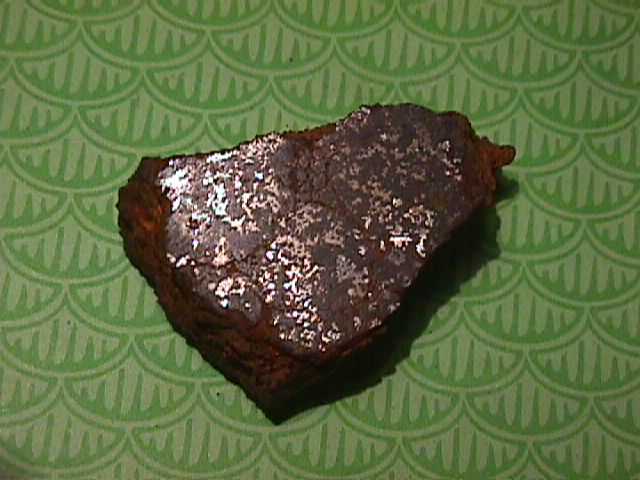
Lamont, Kansas; Mesosiderite, (stony-iron) 70.6 grams. Notice the numerous iron-nickel inclusions scattered throughout a stony matrix in a nearly 50-50 mix.
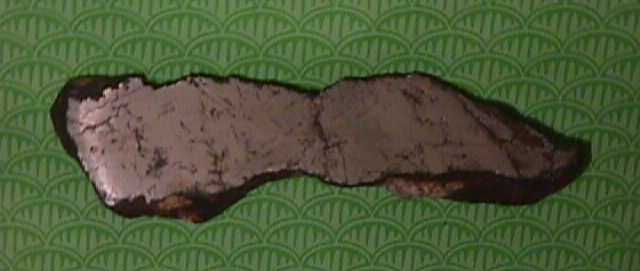
Canyon Diablo, Arizona, ("Meteor Crater") iron meteorite, 245 g. In this specimen cut lengthwise the solid malleable metal interior is revealed.
2 )
Is it rusty brown, or black?Most meteorites are rusty brown if they have been on the ground for an appreciable amount of time. This occurs because iron and iron grains in them rust with exposure to the earth's environment, and will coat the rock with a layer of oxides. On stone meteorites this will look like a dark brown varnish and with solid iron-nickel meteorites this is often a thick crust that flakes away.
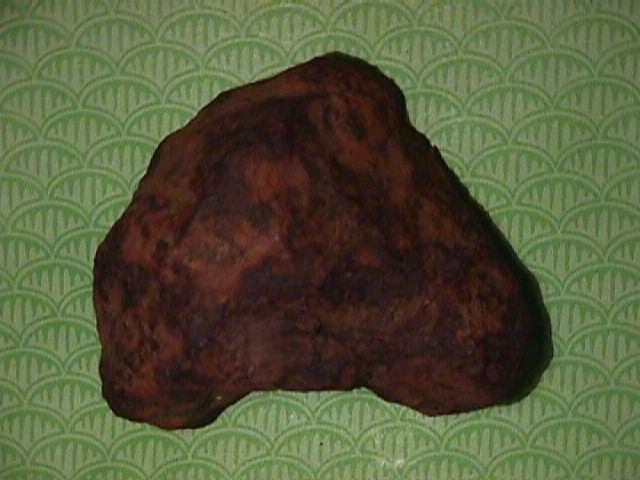
Toluca, Mexico, iron meteorite, 658 grams. This meteorite has a thick oxide coating that flakes away. Inside it is solid metal.

Macy, NM; L-6 (weathered stone), 368 grams. Notice the tan-brown surface with dark brown patches of fusion crust.
3 )
Does it have a rusty brown, to black fusion crust?When meteorites are relatively fresh they often have a thin black crust of melted rock, or with iron meteorites a bluish black crust. This crust is usually very thin, only a few millimeters in thickness, but it is distinct enough to aid in identification. Unless very weathered, almost all meteorites will have traces of fusion crust, which is distinctly different from the interior matrix.
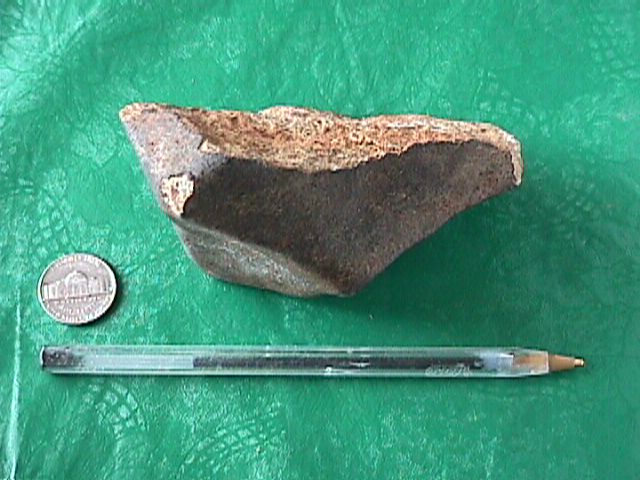
Campos Sales, L-5 (stone), 571 grams. Notice the dark smooth fusion crust, and lighter chalky interior matrix that is speckled with rust spots.
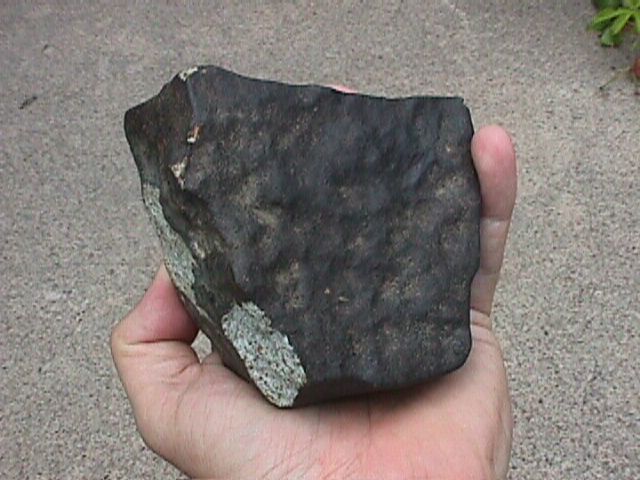
Campos Sales, Brazil, L-5, (stone) 960 grams. Notice the exceptional black fusion crust and thumbprints on this very fine specimen. The light patches are where the fusion crust was broken on impact, thus revealing this meteorite's light gray chalky stone interior. The broken surfaces are speckled with rust spots where atmospheric moisture has caused the malleable iron grains to discolor an otherwise mostly light gray matrix. This specimen was picked up very shortly after falling to earth on Jan. 31st, 1991 and is typical of most freshly fallen meteorites.
4 )
Is it solid, and lacking bubble holes?Meteorites very rarely ever have bubble holes (vesicles or vugs). But there are a few exceptions, and one of these if it had not been an observed fall would have been discounted as a meteorite. So, if the rock has large holes all over it, and also inside a broken surface, then the chances of it being a meteorite are very, very remote.
5 )
Does the exterior of the stone look smooth, or have rounded edges? Does it have what look like shallow "thumbprints."These are characteristic features of most freshly fallen meteorites, as well as many finds that were not witnessed to fall. During the hypersonic phase of the meteoroid's passage through the atmosphere as a meteor, surface temperatures are so extreme that the rock vaporizes. This vaporization is so violent and quick that very little if any heat travels into the interior of the stone, or iron before it is vaporized away. In other words, the meteoroid is vaporizing faster than heat can conduct into it. This is similar to effect to thrusting a chunk of ice into and out of a blast furnace. If the block of ice is large enough a piece of ice will survive. Likewise, the rock or iron that survives the fiery passage through the earth's atmosphere often arrives on the ground at a temperature very close to what it was when it was in space. And this is usually ice cold, but often slightly warm to the touch, especially if it fell during the daytime.
Contrary to popular belief, most meteorites do not arrive onto the surface of the earth burning. The burning fireball phase (bolide) usually terminates 15 to 20 miles above the earth, and the rock simply falls to the ground just as a solid object would if dropped from a high altitude. Compared to the spectacular celestial display meteoroids cause as their cosmic velocity is slowed during the bolide phase, the actual arrival of a meteorite on the ground is usually accompanied by nothing more than a thud and a small impact pit.
Fortunately, our planet's atmosphere slows most meteoroids down enough so that true crater forming events are rare. But for freshly fallen meteorites the surfaces of such often display a texture that is clear evidence of a fiery passage through the atmosphere. Edges are somewhat rounded, and any broad surfaces often have peculiar markings called "thumbprints" (as if the rock were plastic and someone picked it up).
Glorieta Mountain, NM; Siderite (iron), 320 grams. Notice the "thumbprints" on this exceptionally beautiful specimen. Also present are traces of blue-black fusion crust. A space rock like this is too nice to cut or grind. But inside it looks like steel.
6 )
Is the rock magnetic and when a magnet is suspended on a string and brought near to it, is it attracted?Nearly all meteorites have iron-nickel and some are completely iron-nickel. Except for the very rare iron free meteorites, almost all meteorites will mutually be attracted to, or by a magnet.
7 )
Did you actually see the rock hit the ground?Often I receive rocks that the finder swears they saw strike the ground. The finders are adamant that the fireball plunged to the ground.
"I saw a meteor flaming all the way to the ground last night and when I went out to look for it, I found this in the spot where it hit" they often say.
A fireball (bolide) was observed, but if anyone saw it burning all the way to the ground (horizon) it was actually many, many hundreds of miles away. The terminus of such events occurs between 15 to 20 miles above the earth, and at that point the "burning" phase often ends with huge explosion, or simply fades out. But if it hit burning all the way to the ground an explosion akin to that of an atomic bomb would surely be the result. The amount of kinetic energy in meteoroid traveling at 7 to 30 or more miles per second is enormous, and fortunately our planet's thick blanket of air protects its surface (and us) from constant bombardment. If this were not so then even a small pea sized rock or chunk of iron hitting the ground at 30 miles per second would explode with the force of a 500 lb bomb and create a crater yards in diameter. Our world would look like the moon if it were not for our atmosphere burning these cosmic interlopers up.
But such events do occur.
For if a large enough object enters the atmosphere, and then reaches the ground with even a fraction of its cosmic velocity, cratering can be extensive. The Sikhote Alin event in the former USSR on Feb 12, 1947 was the last such recorded cratering event.
Fortunately, crater forming events are rare in terms of the scale of human history, and most meteorites that fall to earth simply plunge to the earth's surface innocuously. Freshly fallen specimens are usually found beneath the track of observed fireballs, or directly under the point over the ground where the fireball terminated.
Freshly fallen meteorites, whether small or large will show (unless fragmented) some amount of fusion crust. This crust is usually dark gray to black, but in some instances such as in the rare Cumberland Falls Meteorite, Norton County Meteorite, and the Pena Blanca Springs Meteorite (observed falls) fusion crust can look like a thin tan to dark brown varnish.
Fusion crust is one of the primary characteristics that one looks for in the process of meteorite identification. Except for very weathered specimens most will have a fusion crust or traces of it, and learning to identify it is important in sorting out meteorites from "meteorwrongs"
Often after a fireball event people are excited enough to go out and look for meteorites, and previously fallen ones not related to the event that sparked one to search are sometimes found. Thus it pays to search after a major fireball sighting.
So, if your rock meets most if not all of these meteorite identification points, then there is a fair chance that it is genuine. You should then send it, or at least a postage sized piece of it to a university that specializes in meteorites or to an authority, such as myself.
I offer meteorite identification services at no cost, other than a small sample. Should your rock prove to be a meteorite, then I will evaluate it and give you an idea as to what it is worth.
However, should you submit a sample, include with it a clearly written e-mail address or a stamped-self-addressed-envelope so that I can return a reply. And if you wish to have your test sample returned please include sufficient postage for me to do so.
Email: meteorite_identification@yahoo.com
Steve Schoner
American Meteorite Survey
P. O. Box 1003
Flagstaff, AZ 86002
METEORITE PICTURE GALLERY
:(Click on the highlighted "htm" file then use "back" option in your browser to close the pictures and return to this page)
STONES:
ABEE, CANADA ABEE.htm
CORREO, NEW MEXICO
CORREO.htmGOLD BASIN, ARIZONA
GOLDBASIN.htmHOLBROOK, ARIZONA
HOLBROOK.htmLAFAYETTE, INDIANA
LAFAYETTE.htm
STONY-IRONS:
GLORIETA MOUNTAIN, NM
GLORIETA.htmLAMONT, KS
LAMONT.htmQUIJINQUE, BRAZIL
QUIJINGUE.htm
IRONS:
CANYON DIABLO
CANYON DIABLO.htmBRENHAM, KS
BRENHAM.htm
And...
Dr. Harvey Nininger & me.
Nininger.htm
(More photos will be added in the near future. And there will also be a photo gallery of "meteorwrongs" that I have received.)
THE NATURE OF METEORITES
(Under development. Please return at a later date)
Copyright Steven R. Schoner 2000